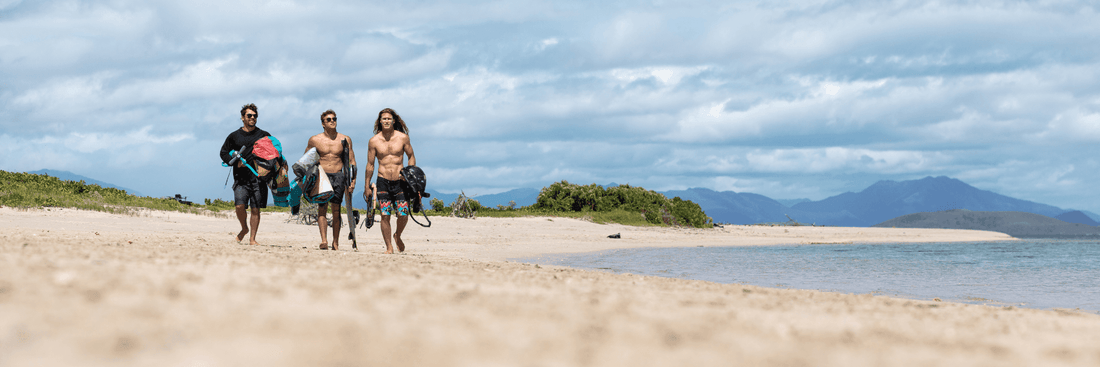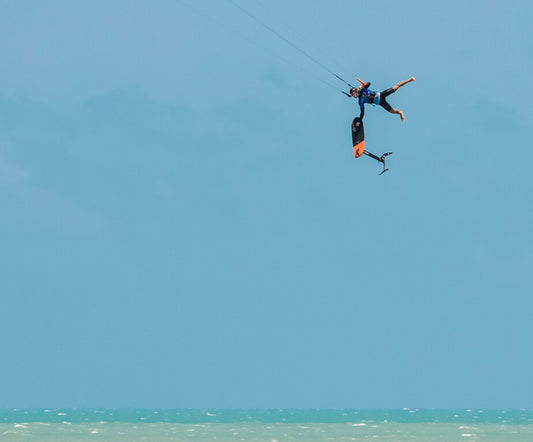New kite spot - What to watch out for?

Rocking up to a spot you’ve never kited before can be a little intimidating. For good reason! There might be hidden rocks lurking in the water, or the wind may get fluky at a particular time…Informing yourself before heading out is key!
With this article, Duotone would like to help ensure your next session at an unknown spot will be smooth, safe and ultimately more exciting. In addition, Duotone are stoked to announce a major brand-new feature in the Academy App: SPOTS, which has been created to make it even easier for you to find kite buddies to ride with.
Before arriving at the spot:
- Get in touch with home spot & checked-in Academy App users
- Research local regulations
- Reach out to local kite schools on-site
- Check the forecast
At the spot:
- Ask the locals if there’s anything to look out for
- Establish wind strength and choose kite size accordingly
- Risk assessment
- Keep an eye on the weather
- Have an exit plan if you need to perform a self-rescue
- Check there's someone to help with launching & landing
FIND VALUABLE INFO ABOUT VIA THE SPOTS FEATURE

The new SPOTS feature in the Academy App helps you every step of your journey to your first session at a new location. When you find the spot you'd like to ride on the map, you can choose to get directed there via Google Maps. As well as you're able to go through the content other App users have posted from the spot to get a better picture of what it looks like. Further, the new feature shows you marked the spot as their home spot and which App users are currently checked-in.
Through DIRECT MESSAGES, you can text those users, which is a fantastic tool to get information first-hand if you got any questions about the conditions at the spot. Or even to arrange a meeting up to go for a session together! The SPOTS feature also makes you aware of any DUOTONE PRO CENTER in the area, which is the perfect place to reach out to for any help or advice you may need.
RESEARCH LOCAL REGULATIONS

It's ’s crucial to inform yourself and to be well aware of the local situation before hitting the water.
Please check:
Where are you allowed to kite?
Is there a particular kite zone (maybe separated from swimmers, windsurfers, boat users etc.)?
Where is the safest place to launch and land your kite?
Are there any specific local rules and regulations when it comes to kiting?
Ensure you do your research into local regulations in advance!
REACH OUT TO A LOCAL KITE SCHOOL
 When visiting a new spot, find the local school, be friendly, ask where to go and if there are things you should know about the spot before going into the water.
When visiting a new spot, find the local school, be friendly, ask where to go and if there are things you should know about the spot before going into the water.
The kiteboarding community is really welcoming, everyone helps each other.
If you arrive at a new spot don’t hesitate to ask how the spot is working and any little tips or advice you might need to kite safely.
CHECK THE FORECAST
 It’s always good to check the forecast a few days in advance.
It’s always good to check the forecast a few days in advance.However, often the weather conditions can change quite quickly, so make sure to keep checking the weather on the internet right up to arriving at the spot.
What’s the wind going to do throughout the day?
What direction will the wind be blowing from?
Will the wind direction stay the same or change?
Will the swell pick up?
Is there any bad weather coming?
ASK LOCALS IF THERE IS ANYTHING TO LOOK OUT FOR

The most important thing is to go and talk to a local. See where and if you are allowed to kite at the spot. Ask where the rocks and reef are, where to get in.
No matter what level you are a local will always know more than you on how the spot works and it’s good to show respect and reach out to the local community.
In general, everyone is friendly and they’ll likely be able to give you a launch when you need it!
ESTABLISH THE WIND DIRECTION & STRENGTH

You can quickly establish the wind direction with the help of flags, trees, flying sand or grass, rising smoke or wind waves. Different wind directions come with their own benefits and challenges. Some are optimal for new kiteboarders, and others are reserved for advanced kiteboarders only.
Side-shore is the safest wind direction, perfect for kiting.
Also, side-onshore and onshore are safe for all kiters, i.e. beginners, intermediate and advanced.
Offshore wind, however, is a definite no-go for anybody! If things go wrong in offshore wind, it may be impossible to get back to land. Cross-offshore is suitable only for experienced kitesurfers. Further accidents often happen because people overestimate their skills or believe they are stronger than Mother Nature. Therefore, always choose your right kite according to the conditions.
If there are other riders out, observe them for a while and try to determine what size kite they are using. This only serves as a reference; you will need to adjust your kite size based on your weight and board size, plus the differences between you and the other riders regarding riding style, skill level and gear.
RISK ASSESSMENT
 When arriving at a new spot, checking the surroundings is very important for many reasons. If there is no one there to ask, you’ll need to do a risk assessment yourself, and thus establish obstacles to avoid, wind obstructions from upwind of you and so forth. It only takes a few minutes and can make a huge difference to your session!
When arriving at a new spot, checking the surroundings is very important for many reasons. If there is no one there to ask, you’ll need to do a risk assessment yourself, and thus establish obstacles to avoid, wind obstructions from upwind of you and so forth. It only takes a few minutes and can make a huge difference to your session!
RISK ASSESSMENT CHECKLIST:
- Is there enough space for you to safely launch and land your kite?
- Ensure clear, easy and safe access to the water before launching your kite.
- Analyze the kite zone on the water thoroughly, before launching your kite.
- Further check and inform yourself about potential rip currents or different water conditions at the spot.
KEEP AN EYE ON THE WEATHER
 Before heading to the spot, ensure you know the current weather and forecasted developments well. This way, you reduce the risk of being surprised by a sudden change in the weather, which can turn a pleasant session into a hazardous situation.
Before heading to the spot, ensure you know the current weather and forecasted developments well. This way, you reduce the risk of being surprised by a sudden change in the weather, which can turn a pleasant session into a hazardous situation.
Always watch the clouds around you before and during your session and immediately note any signs of a change in weather.
Remember that thunderstorm fronts can move upwind! Also, avoid going out in gusty conditions.
HAVE AN EXIT PLAN
 Whether you’re an experienced kiter or a beginner, and even if you use brand-new gear, there’s always the risk of both equipment failure and operator error (i.e. you actually mess up and get yourself into a kitemare).
Whether you’re an experienced kiter or a beginner, and even if you use brand-new gear, there’s always the risk of both equipment failure and operator error (i.e. you actually mess up and get yourself into a kitemare).
Therefore, it’s crucial to always have an exit plan.
This exit plan must be established BEFORE you even start thinking about going out. If there is no safe exit strategy, DO NOT GO OUT !!
What is considered a safe exit: A safe area downwind, where you can swim in or self-rescue yourself to with the help of your kite, such as a sandy beach as opposed to a coastline of high cliffs, dry reef, big waves or any dangerous obstacles.
MAKE SURE THERE IS SOMEBODY TO HELP YOU LAUNCH & LAND YOUR KITE
 A high percentage of accidents in kiting happen during launching and landing. It is always safer to ask somebody to give you a hand than to perform a self-launch / self-land
A high percentage of accidents in kiting happen during launching and landing. It is always safer to ask somebody to give you a hand than to perform a self-launch / self-land
Don’t be afraid to engage with the local kiters, that’s what makes kiteboarding so unique, everyone helps each other, from launching to landing and way beyond.
We wish you all the fun in the world discovering new spots, happy kiting & stay safe!





